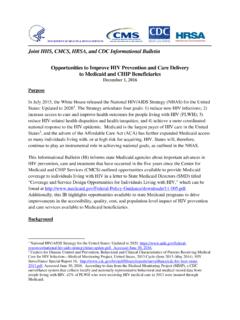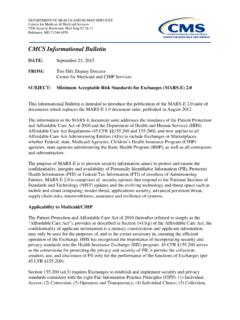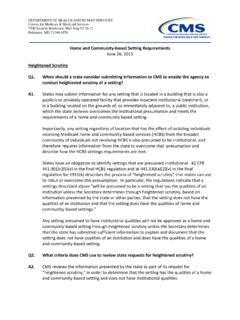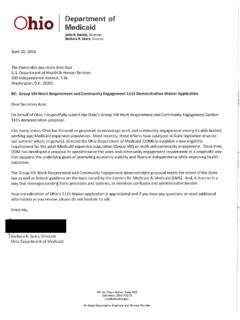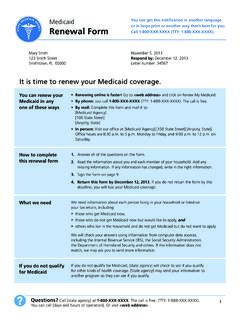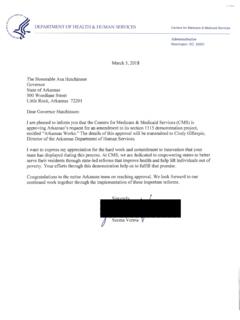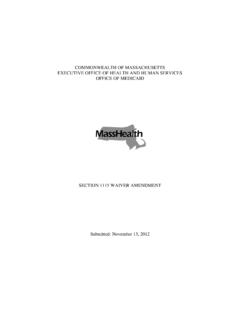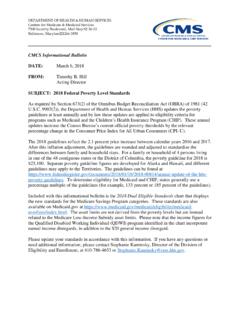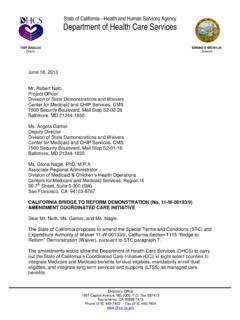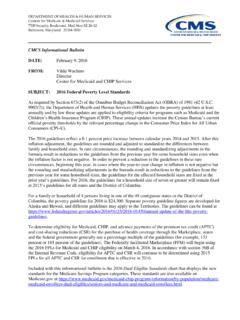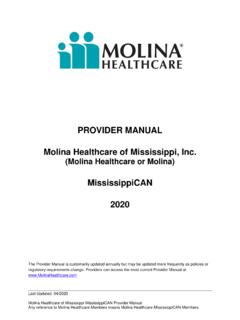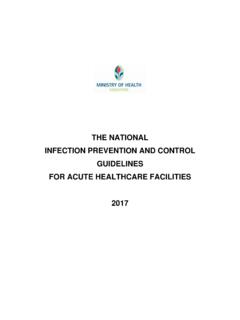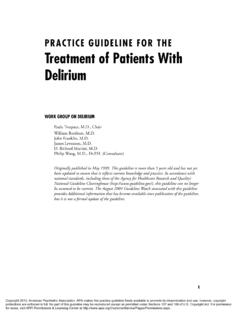Transcription of Managed Care in Minnesota - Medicaid.gov
1 Managed care in Minnesota This profile reflects state Managed care program information as of August 2014, and only includes information on active federal operating authorities, and as such, the program start date may not reflect the earliest date that a program enrolled beneficiaries and provided services. Some states report populations and services available to program participants under the federal authority ( Section 1115 waiver), so these features cannot be easily distinguished for each program. Overview of Current Managed care Programs In July 2011, about two thirds of medicaid beneficiaries were enrolled in one of four Managed care programs, most of which are available statewide. Minnesota 's experience with Managed care began in 1985 with a federally-authorized demonstration program allowing mandatory enrollment into HMOs in the Minneapolis area for some beneficiaries called the Prepaid Medical Assistance Program.
2 In 1993, the state introduced a subsidized insurance program for Minnesotans who have somewhat greater assets than people eligible for PMAP, but no other access to public or private health insurance. This program, called the MinnesotaCare program, converted to a prepaid Managed care program in 1996. The programs were merged in 1996, when mandatory enrollment expanded to other parts of the state. The Minnesota Families and Children programs currently still include the Prepaid Medical Assistance Program (PMAP) and MinnesotaCare. PMAP is a mandatory Managed care program for medicaid -eligible adults, families and children in Minnesota , operating under 1932(a) authority. MinnesotaCare is a health insurance program for low income individuals and families who meet certain income, residency and program requirements, including payment of applicable monthly premiums, operating under 1115(a) authority.
3 The programs are operational in all 87 counties of the state. Enrollees are served by eight Managed care organizations (MCOs). Certain medical assistance eligible populations are exempt from enrollment, including individuals with disabilities and those with a spenddown. PMAP and MinnesotaCare provide acute, primary, specialty, long term, and behavioral health services to children and low-income adults; it also served older adults until Minnesota Senior care was introduced in 2005. The Senior care program covered additional benefits in 2009 and expanded to additional counties in 2008 and 2009, at which point it was renamed Minnesota Senior care Plus (MSC+). MSC+ currently provides acute and long term services and supports to duals as well as medicaid -only beneficiaries, but dual eligibles receive any Medicare covered services on a fee-for-service basis or through a separate Medicare Advantage plan or prescription drug plan.
4 Dual eligibles over age 65 who wish to receive both Medicare and medicaid benefits from the same plan can opt to enroll in Minnesota Senior health Options (MSHO), which started in 1997 and provides acute, specialty care , long term supports and services, behavioral health , and pharmacy benefits through Medicare Advantage Special Needs Plans (MA-SNPs) offered statewide. In both MSHO. and MSC+, nursing facility stays up to 180 days are covered in the capitation rate. Individuals with disabilities under age 65, including dual eligibles, may enroll in Special Needs Basic care (SNBC), which began in 2008 and offers medicaid - covered acute services, behavioral health , and some nursing facility care (100 days). From 2001 to 2010, the state also operated the Disability health Options Program in the Minneapolis/St. Paul area which provided individuals with disabilities under age 65, including dual eligibles, with all acute, primary, behavioral health and long term supports and services; individuals who were enrolled in this program now participate in SNBC.
5 For individuals enrolled 1915(c) home and community-based service waivers, Minnesota also uses a 1915(b) authority to allow the counties to send a person to a specific provider for their services, through the Consolidated Chemical Dependency Treatment Fund, started in 1998, and the Case Management Waiver, started in 2007. Participating Plans, Plan Selection, and Rate Setting Eight local, nonprofit plans currently provide Managed care in Minnesota , including three county-based purchasing plans (Itasca Medical care , Metropolitan health Plan, and South Country health Alliance) which are owned and operated by the rural counties in which they are located. Many plans participate in all Managed care programs, but health Partners and Itasca Medical care only participate in PMAP+ and MSC/MSC+. Starting in 2012, Minnesota selects plans through a competitive bidding process in the Twin Cities area, which evaluates plan bids on cost and quality (50:50); it sets rates through an administrative process using actuarial analyses.
6 quality and Performance Incentives Minnesota collects HEDIS and CAHPS data for all of its Managed care programs. For the SNBC program, the state also conducts an annual survey of enrollees with unmet health care needs specific to their disabilities, and for Elderly Waiver enrollees in the MSHO and MSC/MSC+ programs, the state conducts an annual audit of care plans. Like all states, MCOs are required to conduct annual performance improvement projects, but MCOs that operate as Dual Eligible SNPs may use their Medicare performance improvement projects to meet medicaid requirements. The state posts many of its quality reports on the agency's website for public comment. Along with all private payers in the state, the medicaid agency participates in a health care quality initiative called Bridges to Excellence in which it contributes incentive payments proportionate to the share of enrollees for each program.
7 The initiative distributes payments to plans based on performance indicators designed to measure optimal chronic disease care ; per federal regulation, total plan payment cannot exceed 105% of the capitation amount. The state also convenes a number of workgroups devoted to quality topics relevant to the population enrolled in each program; all MCOs must participate in external quality review and clinical practice and performance measurement workgroups, and MSHO/MSC+. plans must also participate in a care coordination workgroup. Table: Managed care Program Features, as of August 2014. 1915(b)(4). MN Prepaid Medical Consolidated Assistance Program Chemical MN. (PMAP)/ MN Senior health Dependency Senior care Plus 1915(b)(4) Case Special Needs Basic Program Name MinnesotaCare Options (MSHO) Treatment Fund (MSC+) Management Waiver care (SNBC).
8 Program Type MCO MCO County Case Manager MCO Selective contracting MCO. Program Start Date July 1995 March 1997 January 1998 June 2005 January 2007 January 2008. Statutory Authorities 1115(a)/1932(a) 1915(a)/1915(c) 1915(b) 1915(b)/1915(c) 1915(b)/1915(c) 1915(a). 1. Geographic Reach of Statewide Statewide Statewide Statewide Statewide Statewide Program Populations Enrolled (Exceptions may apply for certain individuals in each group). Aged X X X X**. Disabled Children & X X X* X X** X. Adults Children X X. Low-Income Adults X X. Medicare- medicaid X (excludes X (excludes X (excludes X (excludes X (excludes Eligibles ( duals ) partial duals) partial duals) partial duals) partial duals) partial duals). Foster care Children X X X**. 2. American Indians/ X X X X. Alaska Natives 3. Mandatory or Voluntary Mandatory Voluntary ** Varies Mandatory** Mandatory Voluntary enrollment?
9 medicaid Services Covered in Capitation (Specialized services other than those listed may be covered. Services not marked with an X are excluded or carved out from the benefit package.). 1. Amendment in house (and soon to be approved) will allow enrollees in certain counties and tribal areas to choose chemical dependency rehabilitation services from any willing and qualified provider instead of being limited to a single provider. These service areas included in the amendment will include Beltrami, Blue Earth, Dakota, Brown, Hubbard and Mahnomen counties, as well as Red Lake and White Earth Nations. There will be no change for medicaid enrollees who are residing in a county that is not part of this amendment and/or individuals receiving services provided under a medicaid Managed care plan. American Indian medicaid enrollees will continue to have the right to receive services from tribal providers, regardless of the county where they reside.
10 2. American Indian medicaid enrollees have the right to receive services from tribal providers. 3. Enrollees who disenroll from MSHO are returned to the mandatory MSC+ program in their county. 1915(b)(4). MN Prepaid Medical Consolidated Assistance Program Chemical MN. (PMAP)/ MN Senior health Dependency Senior care Plus 1915(b)(4) Case Special Needs Basic Program Name MinnesotaCare Options (MSHO) Treatment Fund (MSC+) Management Waiver care (SNBC). Inpatient hospital X X X X. Primary care and X X X X. Outpatient Services Pharmacy X X X X. Institutional LTC X (180 days) X (180 days) X (100 days). Personal care / HCBS X X X X (case management) X. Inpatient Behavioral X X X X X. health Services Outpatient Behavioral X X X X X. health Services Dental X X X X. Transportation X X X X. Participating Plans or **See notes for plans or organizations participating in each program Organizations Uses HEDIS Measures X X X X.
